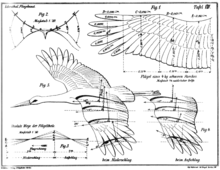Flapping flight

The flapping flight , even rowing flight , powered flight , or fluttering flight is a flight technique used by birds and Fledertieren is used. Every flight from the ground or from the surface of the water requires the mastery of this flying technique. By alternately up and down the wing , propulsion and dynamic lift are generated at the same time , mainly by changing the angle of attack of the arm and hand parts of the wing when up and down.
As a third group of vertebrates , the pterosaurs used this way of flying. The evolution of this flight technique in insects and the three groups of vertebrates took place independently of one another ( convergent ). Other flying forms can be found in all five vertebrate classes , but the majority of them are only capable of passive gliding with a flight skin . Insects also use flapping wings. Due to the much smaller dimensions and the associated lower Reynolds number , the flight of insects differs significantly from the flapping flight of birds and bats.
The attempt to technically imitate flapping flight was also at the beginning of flight technology ( ornithopters ). The successful construction of swing-wing aircraft has so far only been successful in experimental and model flight. In this area, the term swing flight is often preferred.
Birds
The flapping flight is divided into two phases:
- Precipitation ( tee shot ): The wings are flapped down and forward with great force. The arm swing close to the torso provides most of the buoyancy. The hand swings generate propulsion through a rapid downward swinging movement. The hand wings are largely closed. Precipitation is the wing movement mainly responsible for lift and propulsion.
- Serve : arm and hand wings are bent backwards and upwards. The swing arm swivels in such a way that its profile forms a small angle of attack to the incoming air. In the case of smaller birds, the outer hand wings are loosened up like a blind during this upward movement and the wings are almost completely folded in and moved upwards and backwards close to the body, where the wings unfold. There is no lift during the upstroke phase, which is compensated for by a more rapid succession of wing beats.
The flap of the wing thus encloses an ellipse pointing from the back top to the front bottom. The swing of the hand has a larger path (angle) than the arm. The position and shape of the wing changes continuously. When teeing off, the leading edge points diagonally downwards, when serving up diagonally. The flapping of the wing generates a force opposite to the direction of flapping. Blow wind and head wind result in the powerful blowing wind. Due to the changed wing position during upstroke and downstroke, it can attack in such a way that lift is generated in both flapping phases, with the upstroke causing a significantly smaller lift. The bird's body (trunk) always makes a countermovement to the wings.
The flapping flight increases the energy metabolism of a bird, depending on its size, up to twenty times the basic metabolism. This is why many birds sprinkle longer gliding phases during the rowing flight for recreation . In addition, larger and heavier bird species have developed more energy-saving flight methods, for example with gliding , in order to cover longer distances.
| Wing beats per minute |
Airspeed (km / h) |
|
|---|---|---|
| sparrow | 630 | 42 |
| Kestrel | 300 | 75 |
| Common Swift | 710 | 130 |
The rowing flight is the most common active flight of birds.
Bats
The wing precipitation corresponds in principle to that of the birds. In the upstroke phase, however, the upper and lower arm are flexed and pulled towards the body, which shortens the wing. The hand wing hardly deforms here, the leading edge of the wing remains straight. A movement like that of birds is not possible, otherwise the flight membrane would inflate and create resistance.
Technical replica of the flapping flight
The first attempts by Leonardo da Vinci to construct a technical flying object are based on the flapping flight of birds. In practice, other principles have then proven more workable. It was not until 2011 that Festo was able to present a success with the SmartBird at the Hanover Fair .
literature
- E. Bezzel / R. Prinzinger: Ornithology . Ulm-Stuttgart. 2nd edition, 1990. ISBN 3-8001-2597-8 .
- Otto Lilienthal : The flight of birds as the basis of the art of flying . A contribution to the systematics of flight technology. R. Gaertners Verlagbuchhandlung, Berlin 1889, ISBN 3-9809023-8-2 ( digitized and full text in the German Text Archive , digitized [accessed on August 30, 2017] reprint of the original edition, Friedland 2003).
- Walter Birnbaum: The even problem of the flapping wing . 1922.
See also
Individual evidence
- ↑ Die Welt : Robot Bird “SmartBird” flies like a real seagull , April 4, 2011, accessed on September 21, 2011